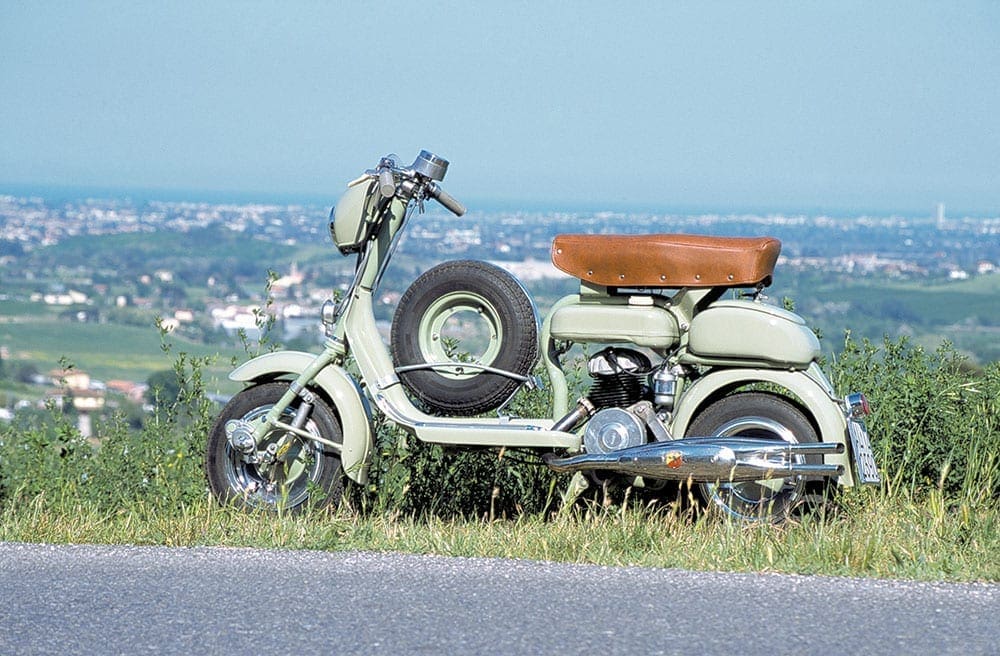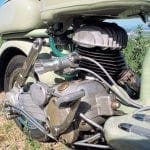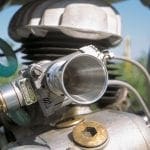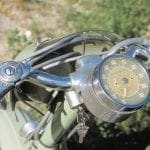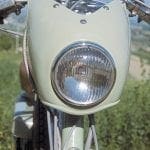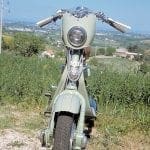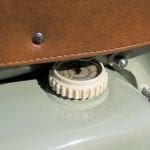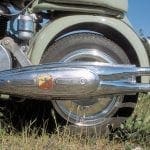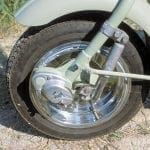It’s easy to forget in today’s world of off-the-shelf consumerism that much of what we take for granted today has evolved from small beginnings many years ago.
Take tuning scooters for example. Ignoring Lambrettas for a moment as they are not a currently manufactured brand, and throughout Europe you can purchase mass-produced go-faster goodies for the majority of established marques courtesy of established companies such as Malossi, Polini, Hebo, Top Performance, Leo-Vinci, Sito, Gianelli and more, without too much difficulty.
As such it’s not unusual to come across enthusiasts that have fitted numerous bits t o their scooters so as to improve its performance. There’s even an abundance of similar goodies for the old Lambrettas out there (although predominantly aimed at the Li range of engines) and while scooter racing or road trials are simply not the crowd puller they used to be in the 40s and 50s, fans of two-wheeled motorsport can still enjoy Moto GP or World Superbikes, either live or televised. In fact the latter, Superbikes, is probably the closest modern day comparison to what we have here, although I do ask you to grant me a little artistic licence as I briefly associate a 125cc scooter that’s heading towards pensionable age, with 21st century motorcycle of nigh-on 1000cc and a lop speed approaching 200mph.
The rules of Superbikes are (or were the last time l looked) based along the lines that the machine in question was supposedly not too far off what the manufacturer offered for sale in one of their franchised showrooms. ln MotoGP, like F1 in the car world, the vehicles are simply specific race machines, although some technology may one day filter down to the showroom.
For the factory Superbike teams this meant ‘applying’ the rules as flexibly as possible, for example crafting ultra light magnesium wheels casting thousands of pounds, tuning the engines to the best of their R&D department’s ability and generally tweaking whatever, wherever they could. For private teams, their motorcycles usually consist of engines and frames purchased from the factory, and then bolting on as many ‘go faster’ parts as money will allow. Which brings us nicely to Paolo’s Lambretta D Racer here, which as far as we know is the equivalent of a privateer’s Superbike from the 50s scooter scene in Italy.
When I first met Paolo, a few years ago now, he had a beautiful red Lambretta D Racer. While this type of scooter was not unfamiliar to me, his was probably the first I saw outside the environment of a museum. This ‘in the garage and in use’ D Racer flicked a switch somewhere in the depths of my head, turning me on to a range of scooters that I’d previously felt best left to old boys with white hair, happy to potter around at a ‘concours d’elegance’ upon. They were cute, part of the great Innocenti history, but as appealing to me as a 150 but without the weather protection!
Paolo’s old racer, however, was something else. There was something about its style that was intriguing and even though I knew that the prehistoric tuned engine would struggle to impress me, even compared to a Li 125, I wanted a go. Paolo explained that this old D wasn’t actually a ‘real’ racer but one he’d built using parts located here and there, a retro custom scooter possibly. Even so, I still admired it.
Then he told me he was selling it, to fund a new machine that he’d bought for a ‘good price’, This intrigued me even more, and if I’m honest particularly the ‘good price’ bit. Well, I wasn’t to be disappointed on the jealously front at all, for the Lambretta you see here is the one, both gorgeous and affordable!
Back in the day, both Piaggio and Innocenti struggled to prove their scooters’ worth in a two-wheeled world dominated by motorcycles. The fact that they were novel, competitively priced and easy to operate of course helped sell a few, but these new Vespa and Lambretta ‘scooter things’ were still being mocked by most. That was until they were entered in competitive events and began to kick the motorcycling fraternity in the pillion seat!
In Pontedera and Milan the engineers at the Piaggio and Innocenti factories tweaked and tuned their machines to gain a little bit more, and like the motorcycle race teams of today, developments founds their way down to the showrooms (the swept back legshields of the Vespa GS for example appeared on a racer a good two years ahead of the popular road-going model).
After their initial impact and success however, the factories slowed down a little on the sporting development. Milestones such as the 125cc speed record won by an Innocenti developed version of a Lambretta for example led to the redistributing of vital resources elsewhere, the ‘suits’ happy that their scooters had been proved now concentrated on securing market share before the opposition.
You can’t turn a talented grease monkey into a marketing executive overnight however, so, cleverly, Innocenti used their sporting success to a double advantage. Their talented engineers in R&D continued to develop sporting parts for their scooters, but rather than factory teams entering each and every event as before, the factory instead backed local franchises and specialist dealers who, in a nutshell, did the hard work for them. This not only kepi the Lambretta name on everybody’s lips, but continued success helped everybody in the long run.
To the best of his knowledge, Paolo’s scooter is one of those racers built from factory produced parts and expertise. In the engine department it can boast a mildly tuned barrel with a 54mm single ring piston, a high compression head, a rare (today) SSI20mm Dell’Orto racing carburettor and an Abarth large bore exhaust that looks and sounds sweet, and of course adds a little to the performance.
This, by the way, is a scooter that cruises at around 45mph and has a top speed that Paolo admits he hasn’t really pushed it to. Needless to say however, the maximum book speed of a standard comparative Lambretta at thetime was around 46mph and so it quite happily outperforms that!
Of course it wasn’t all about top speed, and indeed scooter aficionados of the time realised that against motorcycles they were often going to come out second best in this category.
However, scooters were created to be reliable forms of transport and so if you could combine this legendary quality with a little power tweaking then you could succeed. To assist this other modifications were made to this Lambreita, notably the addition of some Pitotti ‘quick release’ 10in aluminium wheel rims, whereas normal Lambrettas at the time were still running on 8in tyres.
To further enhance handling this Racer also boasts auxiliary front and rear dampers, a ‘turning’ headlight bracket keeps the light pointing in the direction you are turning, while the trimmed legshields, mini-fairing, Teleflex drop bars and dual seat all add to the streamlined style (and rider position) of this scooter.
That’s not all mind you, the ultra rare bully box on the back being much sought after, the fuel cap fuel gauge being handy (when stopped anyway) and the uprated electrics a necessary addition as indeed it is today on any old scooter you want to keep running at peak performance.
Since purchasing this Lambretta, back in 2003, Paolo has ridden it and more recently, finished giving it a ‘modest overhaul’ that he felt it needed, tidying up the paintwork in places for example, tweaking a few bits mechanically but altering little overall. I should maybe point out here that Paolo is also the man behind the racinglambrettas.com website, thus his credentials for such machines are proven.
And so I was once again in admiration of one of Paolo’s scooters, another Lambretta racer. Yet with this one I’ve had the pleasure, last year near Imola to be precise. During a rally there he allowed me to ‘play’ with his Racer on the ride-out and what a pleasure it was. The tell-tale whine of the shaft-driven engine a little more urgent on this Lambretta than the standard machines it’s based upon, it pulled smoothly through the gears, each long enough to pull you on and yet while you were almost tempted to ask for another one at top end, another corner or turn arrived in the nick of time to lake your mind on to more pressing mailers — like how the hell did racers back in the day stop successfully on such poor brakes!
With my confidence increasing at every turn of the mountain road, I found myself sliding back into the seat, my knees bracing against the centrally mounted spare wheel, and subconsciously I was going faster. That riding position combined with the eager engine simply encourages such behaviour, honest!
OWNER DETAILS
 Name: Paolo Catani
Name: Paolo Catani
Age: 43
Job: Scooter victim in sunny Tribola
First interest in scooters: Mid-70s, as a child I recall seeing workers on knackered Lambrettas with Gitiliari slope back seats, no side panels and I thought they were horrendous. Things haven’t changed much!
First scooter: A Li 125 Series 3 in 1982. I still have it—or at least I still have the frame. In 2002, for it’s 20th birthday, l restored it as an ‘Stype’ replica Basically it’s now the biggest bitza in the world; Li frame, Italian GP200 engine, TV200 look-alike.
Favourite model: Every scooter has got its own character. It depends on the mood of the day
Favourite style of custom scooter: In the early 80s I was mad for a custom scooter called ‘English Rose’
First rally: Gabicce Mod Rally in 1982. We used to meet up with a lot of Mods from the Rimini area during the weekends throughout the previous year but this was the first time Mods from so many different Italian towns met up together. I remember one lad telling me he had just taken six amphetamines and offered me one I said “no thanks” and he said I was not a proper Mod He was obviously right…
Favourite rally: Isle of Elba, You have all winter to think about it and it takes place in a glorious location I also have great memories of the first Euro Lambretta Jamborees; Strasbourg ‘89 was the first one where people from different countries met up, Holland ‘96 and then Ireland ’98 when I first met my Rimini Lambretta Centre business partner, Dean. The ‘Three Seas Races’ I have attended have also been nice and have great people behind it How could the scooter scene improve: Good question. It is hard to say. In Italy I see lots of new scooterists who are under 30 years of age. Problem is they are more scooterists on the web Forums than actually on the road!
The farthest you’ve ever ridden on a scooter: Ireland, 1998
Happiest scooter memories: Being escorted over the Druidale course by John Ronald and Norrie Kerr during the 2003 LCGB 50th Anniversary on the Isle of Man. A ride I’ll never forget
Likes/dislikes about rallies: I like the camaderie and dislike the fact that once there, there is not much to do
What articles do you like in Scootering: Definitely ‘lnto the Sunset’
Who/what First inspired you in the scooter scene: In the early days the luckier of us In Italy who had the money to make a trip to England brought back copies of Scootermania – those shiny scoots drove me mad at the time
The most useless part you’ve ever bought for one of your scooters: Wal Phillips injector What part would you most like to see developed for scooters: It’s not that I would see anything in particular, I would only get some better quality remade parts for them
SCOOTER DETAILS
Scooter model: Lambretta 125 D Racer
Date purchased: In 2003 for 1500 Euros (about £1000)
Specialised parts: High compression head, SSI 20mm Dell’Orto racing carb, Abarth large bore exhaust, auxiliary (twin) front and rear dampers, ‘turning’ headlight bracket, dual seat, Pitotti rear tool box, Pitotti ‘quick release’ 10in aluminium wheel rims, central cradle spare wheel carrier, Veglia speedo and mounting, Teleflex drop bars, trimmed legshields and a headlight fairing.All of which are original.
Engine: Most parts are listed above, but it runs an original barrel mildly tuned with a 54mm single ring Dykes piston
Otherunique details: LD stator plate and remote coil in the rear butty box, uprated front drum
Speed: It cruises at 45 mph
Hardest pail of the project: Taking the decision to sell the old D-Racer I had personally built about nine years ago and go through with the purchase of this one. Knowing that my old one is in very careful hands now makes me happy, though.
Advice for anyone starting a project: Get as much information as you can before you start. Anything to add: Maybe fitting an extra long-range fuel tank, which l already have, but I am unsure I really want to as the bike has been this way all its life.
Thanks: To my son Riccardo and my wife Valentina for putting up with my passion/job, which often takes me away. Thanks to Deana for helping out when things become tough, his mechanical abilities are just unbelievable. Thanks also to Marco for sharing the love of model Ds with me.

